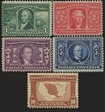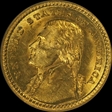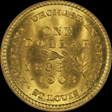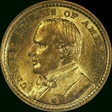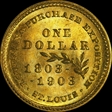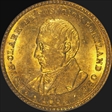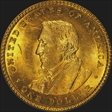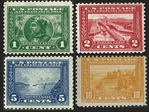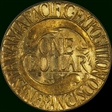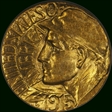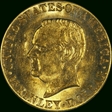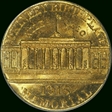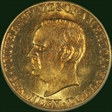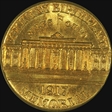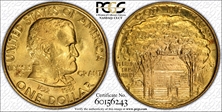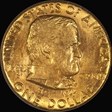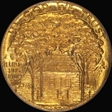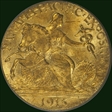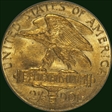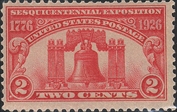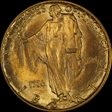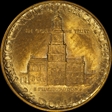The Overland Trail Collection 的钱币相册
The centennial of the Louisiana Purchase of 1903 was the premise for the minting of two commemorative gold dollars. The Jefferson Gold Dollar, depicted below,and the McKinley Gold Dollar were minted in 1902 and 1903 for the centennial in St. Louis in 1904. The Louisiana Purchase Exposition, better known as the St. Louis World's Fair was a year late as the centennial year is 1903, the completion of the Louisiana Purchase from Napoleon of France. Jefferson is depicted on the obverse of the coin, and on the reverse is an olive branch with centennial years 1803-1903. The denomination of one dollar and the inscription "Louisiana Purchase Exposition--St. Louis" completes the design. This is the first gold dollar minted since the discontinuation of the denomination in 1889. The coin, sold at the fair for $3.00 each, met with little enthusiasm. Over 100,000 of the coins minted were returned to Philadelphia for melting. Brilliant proofs were minted (100 coins) signed by the suprintendent and chief coiner of the mint. Proofs today are very rare and should not be confused with proof-like coins of business strikes. The issue has been extensively conterfieted and all specimens should authenicated by a third party grading service. The U. S. Postal Service in 1904 issued commemorative stamps in one, two, three, five, and ten-cent denominations for the exposition. The one and two cent stamps are common issues whereas the three, five, and ten cent are relatively scarce and pricey.
The centennial of the Louisiana Purchase of 1903 was the premise for the minting of two commemorative gold dollars. The Jefferson Gold Dollar, depicted below,and the McKinley Gold Dollar were minted in 1902 and 1903 for the centennial in St. Louis in 1904. The Louisiana Purchase Exposition, better known as the St. Louis World's Fair was a year late as the centennial year is 1903, the completion of the Louisiana Purchase from Napoleon of France. Jefferson is depicted on the obverse of the coin, and on the reverse is an olive branch with centennial years 1803-1903. The denomination of one dollar and the inscription "Louisiana Purchase Exposition--St. Louis" completes the design. This is the first gold dollar minted since the discontinuation of the denomination in 1889. The coin, sold at the fair for $3.00 each, met with little enthusiasm. Over 100,000 of the coins minted were returned to Philadelphia for melting. Brilliant proofs were minted (100 coins) signed by the suprintendent and chief coiner of the mint. Proofs today are very rare and should not be confused with proof-like coins of business strikes. The issue has been extensively conterfieted and all specimens should authenicated by a third party grading service. The U. S. Postal Service in 1904 issued commemorative stamps in one, two, three, five, and ten-cent denominations for the exposition. The one and two cent stamps are common issues whereas the three, five, and ten cent are relatively scarce and pricey.
The centennial of the Louisiana Purchase of 1903 was the premise for the minting of two commemorative gold dollars. The Jefferson Gold Dollar, depicted below,and the McKinley Gold Dollar were minted in 1902 and 1903 for the centennial in St. Louis in 1904. The Louisiana Purchase Exposition, better known as the St. Louis World's Fair was a year late as the centennial year is 1903, the completion of the Louisiana Purchase from Napoleon of France. Jefferson is depicted on the obverse of the coin, and on the reverse is an olive branch with centennial years 1803-1903. The denomination of one dollar and the inscription "Louisiana Purchase Exposition--St. Louis" completes the design. This is the first gold dollar minted since the discontinuation of the denomination in 1889. The coin, sold at the fair for $3.00 each, met with little enthusiasm. Over 100,000 of the coins minted were returned to Philadelphia for melting. Brilliant proofs were minted (100 coins) signed by the suprintendent and chief coiner of the mint. Proofs today are very rare and should not be confused with proof-like coins of business strikes. The issue has been extensively conterfieted and all specimens should authenicated by a third party grading service. The U. S. Postal Service in 1904 issued commemorative stamps in one, two, three, five, and ten-cent denominations for the exposition. The one and two cent stamps are common issues whereas the three, five, and ten cent are relatively scarce and pricey.
The centennial of the Louisiana Purchase of 1903 was the premise for the minting of two commemorative gold dollars. The Jefferson Gold Dollar, depicted below,and the McKinley Gold Dollar were minted in 1902 and 1903 for the centennial in St. Louis in 1904. The Louisiana Purchase Exposition, better known as the St. Louis World Fair was a year late as the centennial year is 1903, the completion of the Louisiana Purchase from Napoleon of France. Jefferson is depicted on the obverse of the coin, and on the reverse is an olive branch with centennial years 1803-1903. The denomination of one dollar and the inscription "Louisiana Purchase Exposition--St. Louis" completes the design. This is the first gold dollar minted since the discontinuation of the denomination in 1889. The coin, sold at the fair for $3.00 each, met with little enthusiasm. Over 100,000 of the coins minted were returned to Philadelphia for melting. Brilliant proofs were minted (100 coins) signed by the suprintendent and chief coiner of the mint. Proofs today are very rare and should not be confused with proof-like coins of business strikes. The issue has been extensively conterfieted and all specimens should authenicated by a third party grading service. The U. S. Postal Service in 1904 issued commemorative stamps in one, two, three, five, and ten-cent denominations for the exposition. The one and two cent stamps are common issues whereas the three, five, and ten cent are relatively scarce and pricey
The centennial of the Louisiana Purchase of 1903 was the premise for the minting of two commemorative gold dollars. The Jefferson Gold Dollar, depicted below,and the McKinley Gold Dollar were minted in 1902 and 1903 for the centennial in St. Louis in 1904. The Louisiana Purchase Exposition, better known as the St. Louis World Fair was a year late as the centennial year is 1903, the completion of the Louisiana Purchase from Napoleon of France. Jefferson is depicted on the obverse of the coin, and on the reverse is an olive branch with centennial years 1803-1903. The denomination of one dollar and the inscription "Louisiana Purchase Exposition--St. Louis" completes the design. This is the first gold dollar minted since the discontinuation of the denomination in 1889. The coin, sold at the fair for $3.00 each, met with little enthusiasm. Over 100,000 of the coins minted were returned to Philadelphia for melting. Brilliant proofs were minted (100 coins) signed by the suprintendent and chief coiner of the mint. Proofs today are very rare and should not be confused with proof-like coins of business strikes. The issue has been extensively conterfieted and all specimens should authenicated by a third party grading service. The U. S. Postal Service in 1904 issued commemorative stamps in one, two, three, five, and ten-cent denominations for the exposition. The one and two cent stamps are common issues whereas the three, five, and ten cent are relatively scarce and pricey
The Louisiana Purchase from France in 1903 brought vast unexplored territory under United States control. President Jefferson ordered Captain Meriwether Lewis and William Clark to explore the upper valley of the Missouri River and beyond for a waterway to the Pacific Ocean. Allthough, they failed to find an all-water route to the Pacific, they did explore, with the help of the Shoshone guide, Sacagawea, the vast area of the Missouri and Columbia River Basins. After two years of exploration and 8,500 miles, they returned to St. Louis on March 23, 1806. The Lewis and Clark Exposition was held in 1905 in Portland, Oregon to commemorate the centennial of the Corps of Discovery Expedition. For the expostion the Philadelphia Mint issued two gold dollars dated 1904 and 1905. These gold dollars have the distiction of being the only two-headed coin minted by the United States Mint. On one side of the coin (the side dated 1904 or 1905) is a portrait of Meriwether Lewis and on the other is the portrait of William Clark. The two headed design of the coin also has lead to its scarcity in high grades. The coins are the rarest of all the commemorative gold dollars in high grades as both coins are prone to hairlining and scratching in the open fields of both sides. A few brilliant proofs were issued for both years and are very rare and should not be confused with prooflike business strikes. Both coins have been counterfeited extensively and before purchase should be authenticated by an expert or third party grading service.
The Louisiana Purchase from France in 1903 brought vast unexplored territory under United States control. President Jefferson ordered Captain Meriwether Lewis and William Clark to explore the upper valley of the Missouri River and beyond for a waterway to the Pacific Ocean. Allthough, they failed to find an all-water route to the Pacific, they did explore, with the help of the Shoshone guide, Sacagawea, the vast area of the Missouri and Columbia River Basins. After two years of exploration and 8,500 miles, they returned to St. Louis on March 23, 1806. The Lewis and Clark Exposition was held in 1905 in Portland, Oregon to commemorate the centennial of the Corps of Discovery Expedition. For the expostion the Philadelphia Mint issued two gold dollars dated 1904 and 1905. These gold dollars have the distiction of being the only two-headed coin minted by the United States Mint. On one side of the coin (the side dated 1904 or 1905) is a portrait of Meriwether Lewis and on the other is the portrait of William Clark. The two headed design of the coin also has lead to its scarcity in high grades. The coins are the rarest of all the commemorative gold dollars in high grades as both coins are prone to hairlining and scratching in the open fields of both sides. A few brilliant proofs were issued for both years and are very rare and should not be confused with prooflike business strikes. Both coins have been counterfeited extensively and before purchase should be authenticated by an expert or third party grading service.
The Louisiana Purchase from France in 1903 brought vast unexplored territory under United States control. President Jefferson ordered Captain Meriwether Lewis and William Clark to explore the upper valley of the Missouri River and beyond for a waterway to the Pacific Ocean. Allthough, they failed to find an all-water route to the Pacific, they did explore, with the help of the Shoshone guide, Sacagawea, the vast area of the Missouri and Columbia River Basins. After two years of exploration and 8,500 miles, they returned to St. Louis on March 23, 1806. The Lewis and Clark Exposition was held in 1905 in Portland, Oregon to commemorate the centennial of the Corps of Discovery Expedition. For the expostion the Philadelphia Mint issued two gold dollars dated 1904 and 1905. These gold dollars have the distiction of being the only two-headed coin minted by the United States Mint. On one side of the coin (the side dated 1904 or 1905) is a portrait of Meriwether Lewis and on the other is the portrait of William Clark. The two headed design of the coin also has lead to its scarcity in high grades. The coins are the rarest of all the commemorative gold dollars in high grades as both coins are prone to hairlining and scratching in the open fields of both sides. A few brilliant proofs were issued for both years and are very rare and should not be confused with prooflike business strikes. Both coins have been counterfeited extensively and before purchase should be authenticated by an expert or third party grading service.
The Panama-Pacific Exposition was held in 1915 for the completion of the Panama Canal and the rebirth of San Francisco after the earthquake of 1906. As part of the exposition, commemorative coins in the denominations of half dollar, one dollar gold, quarter eagle and two varieties of quintuple eagle, were minted at the exposition. The obverse of gold dollar depicts a canal worker (sometimes mistaken for a baseball player). The reverse shows the denomination One Dollar surrounded by a pair of dolphins representing the binding of the two oceans by the canal. The San Francisco Mint issued 25,000 coins of which 10,000 were returned to be melted, leaving a net mintage of 15,000. The coins were sold at the exposition for $2.25 each, later reduced to $2.00. The issue met with lukewarm acceptance with few being sold. Counterfeits exist, so that all coins should be authenticated by a third party grading service before acquisition. Several proofs with mirror-like fields were produced with and without the S mintmark, some without reeding, and some in silver. All are extremely rare. The business strikes are common in grades to MS65, but increasingly scarce in grades thereafter. The issue is the most common of the commemorative gold dollars in high grades. As part of the celebration of the exposition four stamps were issued. The philatelic tie-ins to the half dollars are a one-cent green Balboa, a two-cent Panama Canal, a five-cent Golden Gate, and a ten-cent Discovery of San Francisco Bay stamps
The Panama-Pacific Exposition was held in 1915 for the completion of the Panama Canal and the rebirth of San Francisco after the earthquake of 1906. As part of the exposition, commemorative coins in the denominations of half dollar, one dollar gold, quarter eagle and two varieties of quintuple eagle, were minted at the exposition. The obverse of gold dollar depicts a canal worker (sometimes mistaken for a baseball player). The reverse shows the denomination One Dollar surrounded by a pair of dolphins representing the binding of the two oceans by the canal. The San Francisco Mint issued 25,000 coins of which 10,000 were returned to be melted, leaving a net mintage of 15,000. The coins were sold at the exposition for $2.25 each, later reduced to $2.00. The issue met with lukewarm acceptance with few being sold. Counterfeits exist, so that all coins should be authenticated by a third party grading service before acquisition. Several proofs with mirror-like fields were produced with and without the S mintmark, some without reeding, and some in silver. All are extremely rare. The business strikes are common in grades to MS65, but increasingly scarce in grades thereafter. The issue is the most common of the commemorative gold dollars in high grades. As part of the celebration of the exposition four stamps were issued. The philatelic tie-ins to the half dollars are a one-cent green Balboa, a two-cent Panama Canal, a five-cent Golden Gate, and a ten-cent Discovery of San Francisco Bay stamps
The Panama-Pacific Exposition was held in 1915 for the completion of the Panama Canal and the rebirth of San Francisco after the earthquake of 1906. As part of the exposition, commemorative coins in the denominations of half dollar, one dollar gold, quarter eagle and two varieties of quintuple eagle, were minted at the exposition. The obverse of gold dollar depicts a canal worker (sometimes mistaken for a baseball player). The reverse shows the denomination One Dollar surrounded by a pair of dolphins representing the binding of the two oceans by the canal. The San Francisco Mint issued 25,000 coins of which 10,000 were returned to be melted, leaving a net mintage of 15,000. The coins were sold at the exposition for $2.25 each, later reduced to $2.00. The issue met with lukewarm acceptance with few being sold. Counterfeits exist, so that all coins should be authenticated by a third party grading service before acquisition. Several proofs with mirror-like fields were produced with and without the S mintmark, some without reeding, and some in silver. All are extremely rare. The business strikes are common in grades to MS65, but increasingly scarce in grades thereafter. The issue is the most common of the commemorative gold dollars in high grades. As part of the celebration of the exposition four stamps were issued. The philatelic tie-ins to the half dollars are a one-cent green Balboa, a two-cent Panama Canal, a five-cent Golden Gate, and a ten-cent Discovery of San Francisco Bay stamps
William Jennings Bryan armed with his "Cross of Gold'" speech and his "free silver" platform was no match for William McKinley's "sound money" and "a dinner in every pail" platform based on the gold standard. McKinley's victory over Bryan in the election of 1896 was a victory for gold and the death knell for free silver and bimetalism. McKinley was born in Niles, Ohio, served in the War Between the States for the Union, was elected to the House of Representatives, and was Governor of Ohio before becoming president in 1896. As president he guided the nation through the Spanish-American War thus providing independance for Cuba and transforming the United States into a imperial power. McKinley, while attending the Pan-American Exposition in Buffalo, NY, was assassinated by a Leon Czolgosz. The McKinley Gold Dollars were minted to honor the late president to provide funds for a memorial at his birthplace at Niles, Ohio. The coins were at one time to be minted as a silver dollar, but due to McKinley strong stance for the gold standard, was changed to a gold dollar. Coins were minted in 1916 and 1917, identical with exception of the date. The obverse shows a portrait of McKinley, vastly different from the 1903 coin, and very Roman-like in nature. The reverse shows the McKinley Memorial to be built at Niles. Coins were sold, mainly to collectors, at $3.00 each. Response was poor with only 10000 of each date sold of the 30,000 minted. The 1916 issue is more common than the scarcer, more valuable, 1917 coins. Dangerous conterfeits exist for both dates but can usually be distinguished by their shoddy workmanship and lack of detail. Proofs exists for both dates and should not be confused with proof-like business strikes. As with all gold commemoratives authentication by a third party grading sevice should be obtained before purchase.
William Jennings Bryan armed with his "Cross of Gold'" speech and his "free silver" platform was no match for William McKinley's "sound money" and "a dinner in every pail" platform based on the gold standard. McKinley's victory over Bryan in the election of 1896 was a victory for gold and the death knell for free silver and bimetalism. McKinley was born in Niles, Ohio, served in the War Between the States for the Union, was elected to the House of Representatives, and was Governor of Ohio before becoming president in 1896. As president he guided the nation through the Spanish-American War thus providing independance for Cuba and transforming the United States into a imperial power. McKinley, while attending the Pan-American Exposition in Buffalo, NY, was assassinated by a Leon Czolgosz. The McKinley Gold Dollars were minted to honor the late president to provide funds for a memorial at his birthplace at Niles, Ohio. The coins were at one time to be minted as a silver dollar, but due to McKinley strong stance for the gold standard, was changed to a gold dollar. Coins were minted in 1916 and 1917, identical with exception of the date. The obverse shows a portrait of McKinley, vastly different from the 1903 coin, and very Roman-like in nature. The reverse shows the McKinley Memorial to be built at Niles. Coins were sold, mainly to collectors, at $3.00 each. Response was poor with only 10000 of each date sold of the 30,000 minted. The 1916 issue is more common than the scarcer, more valuable, 1917 coins. Dangerous conterfeits exist for both dates but can usually be distinguished by their shoddy workmanship and lack of detail. Proofs exists for both dates and should not be confused with proof-like business strikes. As with all gold commemoratives authentication by a third party grading sevice should be obtained before purchase.
William Jennings Bryan armed with his "Cross of Gold'" speech and his "free silver" platform was no match for William McKinley's "sound money" and "a dinner in every pail" platform based on the gold standard. McKinley's victory over Bryan in the election of 1896 was a victory for gold and the death knell for free silver and bimetalism. McKinley was born in Niles, Ohio, served in the War Between the States for the Union, was elected to the House of Representatives, and was Governor of Ohio before becoming president in 1896. As president he guided the nation through the Spanish-American War thus providing independance for Cuba and transforming the United States into a imperial power. McKinley, while attending the Pan-American Exposition in Buffalo, NY, was assassinated by a Leon Czolgosz. The McKinley Gold Dollars were minted to honor the late president to provide funds for a memorial at his birthplace at Niles, Ohio. The coins were at one time to be minted as a silver dollar, but due to McKinley strong stance for the gold standard, was changed to a gold dollar. Coins were minted in 1916 and 1917, identical with exception of the date. The obverse shows a portrait of McKinley, vastly different from the 1903 coin, and very Roman-like in nature. The reverse shows the McKinley Memorial to be built at Niles. Coins were sold, mainly to collectors, at $3.00 each. Response was poor with only 10000 of each date sold of the 30,000 minted. The 1916 issue is more common than the scarcer, more valuable, 1917 coins. Dangerous conterfeits exist for both dates but can usually be distinguished by their shoddy workmanship and lack of detail. Proofs exists for both dates and should not be confused with proof-like business strikes. As with all gold commemoratives authentication by a third party grading sevice should be obtained before purchase. Beautiful gold toning, prooflike fields
William Jennings Bryan armed with his "Cross of Gold'" speech and his "free silver" platform was no match for William McKinley's "sound money" and "a dinner in every pail" platform based on the gold standard. McKinley's victory over Bryan in the election of 1896 was a victory for gold and the death knell for free silver and bimetalism. McKinley was born in Niles, Ohio, served in the War Between the States for the Union, was elected to the House of Representatives, and was Governor of Ohio before becoming president in 1896. As president he guided the nation through the Spanish-American War thus providing independance for Cuba and transforming the United States into a imperial power. McKinley, while attending the Pan-American Exposition in Buffalo, NY, was assassinated by a Leon Czolgosz. The McKinley Gold Dollars were minted to honor the late president to provide funds for a memorial at his birthplace at Niles, Ohio. The coins were at one time to be minted as a silver dollar, but due to McKinley strong stance for the gold standard, was changed to a gold dollar. Coins were minted in 1916 and 1917, identical with exception of the date. The obverse shows a portrait of McKinley, vastly different from the 1903 coin, and very Roman-like in nature. The reverse shows the McKinley Memorial to be built at Niles. Coins were sold, mainly to collectors, at $3.00 each. Response was poor with only 10000 of each date sold of the 30,000 minted. The 1916 issue is more common than the scarcer, more valuable, 1917 coins. Dangerous conterfeits exist for both dates but can usually be distinguished by their shoddy workmanship and lack of detail. Proofs exists for both dates and should not be confused with proof-like business strikes. As with all gold commemoratives authentication by a third party grading sevice should be obtained before purchase. Beautiful gold toning, prooflike fields
Ulysses S. Grant was born in a small frame house April 27, 1822 at Mount Pleasant, Ohio. Grant spent most of his life doing work he dreaded. He failed at farming, at his family's job of tanning, as a salesman, even as President of the United States. Grant, though not dishonest, had one of the most incompetent and corrupt administrations since Clinton. Grant failed miserably at almost everything but, he did win at Fort Donnellson, at Shiloh, and eventually defeated Lee at Appomattox bringing about the end of the War Between the States. Two commemorative coins, gold dollars and silver half dollars, were minted in 1922 on the 100th aniversary of his birth. Both coins are identical in design with and without a star above his name. On the obverse of the coins is a portrait of Grant in his army uniform. On the reverse depicts his frame house were he was born at Point Pleasant, Ohio. The half dollar with the star is one of the rarest and most valuable of all the silver commemorative issues. The gold dollars are rare with or without star with mintage about 5,000 for each type. The Grant dollars can be easily found in pristine gem condition for a hefty price, but the half dollars, especially those with stars are quite elusive. Counterfiets are abundant for both the half dollars with star and both gold dollars. Certification of authenticity should be sought by a third party grading service before purchase of Grant gold dollars or Grant half dollar with star
Ulysses S. Grant was born in a small frame house April 27, 1822 at Mount Pleasant, Ohio. Grant spent most of his life doing work he dreaded. He failed at farming, at his family's job of tanning, as a salesman, even as President of the United States. Grant, though not dishonest, had one of the most incompetent and corrupt administrations since Clinton. Grant failed miserably at almost everything but, he did win at Fort Donnellson, at Shiloh, and eventually defeated Lee at Appomattox bringing about the end of the War Between the States. Two commemorative coins, gold dollars and silver half dollars, were minted in 1922 on the 100th aniversary of his birth. Both coins are identical in design with and without a star above his name. On the obverse of the coins is a portrait of Grant in his army uniform. On the reverse depicts his frame house were he was born at Point Pleasant, Ohio. The half dollar with the star is one of the rarest and most valuable of all the silver commemorative issues. The gold dollars are rare with or without star with mintage about 5,000 for each type. The Grant dollars can be easily found in pristine gem condition for a hefty price, but the half dollars, especially those with stars are quite elusive. Counterfiets are abundant for both the half dollars with star and both gold dollars. Certification of authenticity should be sought by a third party grading service before purchase of Grant gold dollars or Grant half dollar with star
Ulysses S. Grant was born in a small frame house April 27, 1822 at Mount Pleasant, Ohio. Grant spent most of his life doing work he dreaded. He failed at farming, at his family's job of tanning, as a salesman, even as President of the United States. Grant, though not dishonest, had one of the most incompetent and corrupt administrations since Clinton. Grant failed miserably at almost everything but, he did win at Fort Donnellson, at Shiloh, and eventually defeated Lee at Appomattox bringing about the end of the War Between the States. Two commemorative coins, gold dollars and silver half dollars, were minted in 1922 on the 100th aniversary of his birth. Both coins are identical in design with and without a star above his name. On the obverse of the coins is a portrait of Grant in his army uniform. On the reverse depicts his frame house were he was born at Point Pleasant, Ohio. The half dollar with the star is one of the rarest and most valuable of all the silver commemorative issues. The gold dollars are rare with or without star with mintage about 5,000 for each type. The Grant dollars can be easily found in pristine gem condition for a hefty price, but the half dollars, especially those with stars are quite elusive. Counterfiets are abundant for both the half dollars with star and both gold dollars. Certification of authenticity should be sought by a third party grading service before purchase of Grant gold dollars or Grant half dollar with star
Ulysses S. Grant was born in a small frame house April 27, 1822 at Mount Pleasant, Ohio. Grant spent most of his life doing work he dreaded. He failed at farming, at his family's job of tanning, as a salesman, even as President of the United States. Grant, though not dishonest, had one of the most incompetent and corrupt administrations since Clinton. Grant failed miserably at almost everything but, he did win at Fort Donnellson, at Shiloh, and eventually defeated Lee at Appomattox bringing about the end of the War Between the States. Two commemorative coins, gold dollars and silver half dollars, were minted in 1922 on the 100th aniversary of his birth. Both coins are identical in design with and without a star above his name. On the obverse of the coins is a portrait of Grant in his army uniform. On the reverse depicts his frame house were he was born at Point Pleasant, Ohio. The half dollar with the star is one of the rarest and most valuable of all the silver commemorative issues. The gold dollars are rare with or without star with mintage about 5,000 for each type. The Grant dollars can be easily found in pristine gem condition for a hefty price, but the half dollars, especially those with stars are quite elusive. Counterfiets are abundant for both the half dollars with star and both gold dollars. Certification of authenticity should be sought by a third party grading service before purchase of Grant gold dollars or Grant half dollar with star
The Panama-Pacific Exposition was held in 1915 for the completion of the Panama Canal and the rebirth of San Francisco after the earthquake of 1906. As part of the exposition, commemorative coins in the denominations of half dollar, one dollar gold, quarter eagle and two varieties of quintuple eagle, were minted at the exposition. The obverse of quarter eagle shows Liberty riding sidesaddle backwards abord a hippocampus, a mythical creature half horse and half fish. In the left hand she carries a caduceus repesenting the conquest of yellow fever which had hampered the construction of the canal. The hippocampus swimming represents commerce through the canal. The reverse shows a defiant eagle perched on a pole with the inscription "E PLURIBUS UNUM" along with the denomination 2 1/2 DOL. The San Francisco Mint coined 10,017 specimens of which 6,749 coins sold for $4.00 apeice and 3,268 returned to the mint for remelting. Due to mishandling and spending most specimens are scarce but especially in gem condition (MS65). Dangerous conterfeits exits but usually can be distinguished from the genuine quarter eagles by their shoddy workmanship. All coins should be authenticated by a third party grading service before purchase. As part of the celebration of the exposition four stamps were issued. The philatelic tie-ins to the half dollars are a one-cent green Balboa, a two-cent Panama Canal, a five-cent Golden Gate, and a ten-cent Discovery of San Francisco Bay stamps.
The Panama-Pacific Exposition was held in 1915 for the completion of the Panama Canal and the rebirth of San Francisco after the earthquake of 1906. As part of the exposition, commemorative coins in the denominations of half dollar, one dollar gold, quarter eagle and two varieties of quintuple eagle, were minted at the exposition. The obverse of quarter eagle shows Liberty riding sidesaddle backwards abord a hippocampus, a mythical creature half horse and half fish. In the left hand she carries a caduceus repesenting the conquest of yellow fever which had hampered the construction of the canal. The hippocampus swimming represents commerce through the canal. The reverse shows a defiant eagle perched on a pole with the inscription "E PLURIBUS UNUM" along with the denomination 2 1/2 DOL. The San Francisco Mint coined 10,017 specimens of which 6,749 coins sold for $4.00 apeice and 3,268 returned to the mint for remelting. Due to mishandling and spending most specimens are scarce but especially in gem condition (MS65). Dangerous conterfeits exits but usually can be distinguished from the genuine quarter eagles by their shoddy workmanship. All coins should be authenticated by a third party grading service before purchase. As part of the celebration of the exposition four stamps were issued. The philatelic tie-ins to the half dollars are a one-cent green Balboa, a two-cent Panama Canal, a five-cent Golden Gate, and a ten-cent Discovery of San Francisco Bay stamps.
"We hold these truths to be self-evident: that all men are created equal, that they are endowed by their Creator with certain unalienable rights, that among these are life, liberty, and the persuit of happiness." --Thomas Jefferson--The Declaration of Independence--July 4, 1776. This memorable statement as well the entire declaration is the subject of the Sesquicentennial Quarter Eagle of U. S. Independence. The U.S. Cogress authorized the exposition in Philadelphia to commemorate the 150th anniversary of signing of the declaration as well as the issue of commemorative coins, gold quarter eagles and silver half dollars. The obverse of the quarter eagle shows Miss Liberty standing on the globe, with a torch in the right hand and a scroll, depicting the declaration, in the left hand. The inscriptions, United States of America, Liberty, and the dual date, 1776-1926, encircle the coin. The reverse shows Independence Hall, the birthplace of the declaration, with Sesquicentennial of American Independence and 2 1/2 Dollars along the perimeter of the coin. The coin is struck in very low relief as to barely show the rising sun on the reverse. The low relief, with little protection for the design elements, accounts for the few coins in gem condition. Over 200,000 coins were struck for sale at the Sesquicentennial Expostion in Philadelphia, but disappointingly the expo was a bust with only 5 million in attendence and 46,000 sold. The rest of over 150,000 were sent to the melting pot for reincarnation. The coins are common in lower mint state grades but become exceedingly rare in gem MS65 and above. Shody counterfeits exist but should not be confused with authentic coins. All commemorative gold coins should be certified by a qualified third party grading service before purchase. At least one matte proof exits for the issue from the estate of John Sinnock, cheif engraver of the mint. As part of the celebration of the the sequicentennial exposition the United States Postal Service issued stamps as shown in the scan below.
"We hold these truths to be self-evident: that all men are created equal, that they are endowed by their Creator with certain unalienable rights, that among these are life, liberty, and the persuit of happiness." --Thomas Jefferson--The Declaration of Independence--July 4, 1776. This memorable statement as well the entire declaration is the subject of the Sesquicentennial Quarter Eagle of U. S. Independence. The U.S. Cogress authorized the exposition in Philadelphia to commemorate the 150th anniversary of signing of the declaration as well as the issue of commemorative coins, gold quarter eagles and silver half dollars. The obverse of the quarter eagle shows Miss Liberty standing on the globe, with a torch in the right hand and a scroll, depicting the declaration, in the left hand. The inscriptions, United States of America, Liberty, and the dual date, 1776-1926, encircle the coin. The reverse shows Independence Hall, the birthplace of the declaration, with Sesquicentennial of American Independence and 2 1/2 Dollars along the perimeter of the coin. The coin is struck in very low relief as to barely show the rising sun on the reverse. The low relief, with little protection for the design elements, accounts for the few coins in gem condition. Over 200,000 coins were struck for sale at the Sesquicentennial Expostion in Philadelphia, but disappointingly the expo was a bust with only 5 million in attendence and 46,000 sold. The rest of over 150,000 were sent to the melting pot for reincarnation. The coins are common in lower mint state grades but become exceedingly rare in gem MS65 and above. Shody counterfeits exist but should not be confused with authentic coins. All commemorative gold coins should be certified by a qualified third party grading service before purchase. At least one matte proof exits for the issue from the estate of John Sinnock, cheif engraver of the mint. As part of the celebration of the the sequicentennial exposition the United States Postal Service issued stamps as shown in the scan below.
"We hold these truths to be self-evident: that all men are created equal, that they are endowed by their Creator with certain unalienable rights, that among these are life, liberty, and the persuit of happiness." --Thomas Jefferson--The Declaration of Independence--July 4, 1776. This memorable statement as well the entire declaration is the subject of the Sesquicentennial Quarter Eagle of U. S. Independence. The U.S. Cogress authorized the exposition in Philadelphia to commemorate the 150th anniversary of signing of the declaration as well as the issue of commemorative coins, gold quarter eagles and silver half dollars. The obverse of the quarter eagle shows Miss Liberty standing on the globe, with a torch in the right hand and a scroll, depicting the declaration, in the left hand. The inscriptions, United States of America, Liberty, and the dual date, 1776-1926, encircle the coin. The reverse shows Independence Hall, the birthplace of the declaration, with Sesquicentennial of American Independence and 2 1/2 Dollars along the perimeter of the coin. The coin is struck in very low relief as to barely show the rising sun on the reverse. The low relief, with little protection for the design elements, accounts for the few coins in gem condition. Over 200,000 coins were struck for sale at the Sesquicentennial Expostion in Philadelphia, but disappointingly the expo was a bust with only 5 million in attendence and 46,000 sold. The rest of over 150,000 were sent to the melting pot for reincarnation. The coins are common in lower mint state grades but become exceedingly rare in gem MS65 and above. Shody counterfeits exist but should not be confused with authentic coins. All commemorative gold coins should be certified by a qualified third party grading service before purchase. At least one matte proof exits for the issue from the estate of John Sinnock, cheif engraver of the mint. As part of the celebration of the the sequicentennial exposition the United States Postal Service issued stamps as shown in the scan below.




















